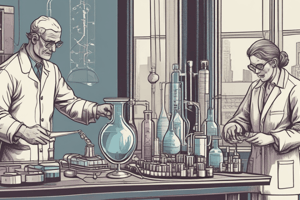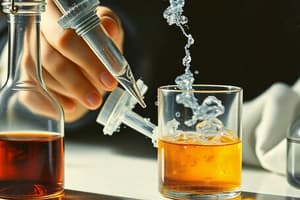Podcast
Questions and Answers
What does Rf stand for in the context of Thin Layer Chromatography?
What does Rf stand for in the context of Thin Layer Chromatography?
- Retention factor (correct)
- Reference factor
- Reactivity factor
- Radiofrequency
In paper chromatography, which of the following phases is the stationary phase?
In paper chromatography, which of the following phases is the stationary phase?
- Cellulose filter paper (correct)
- Liquid solvent
- Gas phase
- Water
If the solvent has travelled 3.5 cm and the sample has travelled 2.8 cm, what is the Rf value of the sample?
If the solvent has travelled 3.5 cm and the sample has travelled 2.8 cm, what is the Rf value of the sample?
- 0.75
- 0.80
- 0.60 (correct)
- 1.25
Which of the following conditions can Thin Layer Chromatography measure amino acid concentration for?
Which of the following conditions can Thin Layer Chromatography measure amino acid concentration for?
What reagent is used in paper chromatography to detect alpha-amino acids?
What reagent is used in paper chromatography to detect alpha-amino acids?
What is the primary purpose of using Thin Layer Chromatography?
What is the primary purpose of using Thin Layer Chromatography?
At what point should the paper chromatogram be removed from the solvent in the chromatography process?
At what point should the paper chromatogram be removed from the solvent in the chromatography process?
Which of these conditions is characterized by the body not fully breaking down tyrosine and phenylalanine?
Which of these conditions is characterized by the body not fully breaking down tyrosine and phenylalanine?
What is the main purpose of chromatography?
What is the main purpose of chromatography?
Which component of a chromatographic system holds the sample being analyzed?
Which component of a chromatographic system holds the sample being analyzed?
In what way do the mobile phase and stationary phase interact in chromatography?
In what way do the mobile phase and stationary phase interact in chromatography?
Which of the following best describes gel exclusion chromatography?
Which of the following best describes gel exclusion chromatography?
What characterizes thin layer chromatography?
What characterizes thin layer chromatography?
What does the term 'elution' refer to in chromatography?
What does the term 'elution' refer to in chromatography?
What drives the separation process in thin layer chromatography?
What drives the separation process in thin layer chromatography?
Which of the following properties is NOT typically used in chromatography for separation?
Which of the following properties is NOT typically used in chromatography for separation?
Flashcards
Chromatography
Chromatography
An analytical technique used to separate closely related compounds from a mixture.
Analyte
Analyte
The substance that is being separated in a mixture.
Stationary Phase
Stationary Phase
The solid matrix through which the sample dissolved in the mobile phase travels.
Mobile Phase
Mobile Phase
Signup and view all the flashcards
Chromatographic Separation
Chromatographic Separation
Signup and view all the flashcards
Eluent
Eluent
Signup and view all the flashcards
Eluate
Eluate
Signup and view all the flashcards
Elution
Elution
Signup and view all the flashcards
What is Rf?
What is Rf?
Signup and view all the flashcards
What is Thin-Layer Chromatography (TLC)?
What is Thin-Layer Chromatography (TLC)?
Signup and view all the flashcards
What is Paper Chromatography?
What is Paper Chromatography?
Signup and view all the flashcards
How to calculate Rf Value?
How to calculate Rf Value?
Signup and view all the flashcards
What are the applications of TLC in biochemistry?
What are the applications of TLC in biochemistry?
Signup and view all the flashcards
What is Phenylketonuria?
What is Phenylketonuria?
Signup and view all the flashcards
What is Alkaptonuria?
What is Alkaptonuria?
Signup and view all the flashcards
What is Maple Syrup Urine Disease?
What is Maple Syrup Urine Disease?
Signup and view all the flashcards
Study Notes
Chromatography Overview
- Chromatography is an analytical technique separating closely related compounds in a mixture.
- It is used to separate proteins, peptides, amino acids, lipids, carbohydrates, vitamins, and drugs.
Physical Basis of Separation
- Compounds are separated based on differences in physical characteristics.
- Examples include molecular size, shape, charge, volatility, solubility, and absorptivity.
Essential Components of Chromatographic Systems
- Stationary Phase: A porous solid matrix, where the sample dissolved in the mobile phase travels through.
- Mobile Phase: The mixture of substances (to be separated) dissolved in a liquid or gas.
General Principle of Chromatography
- All chromatography types involve a stationary and a mobile phase.
- The mobile phase moves through the stationary phase, carrying the sample components.
- Separation happens through continuous redistribution between the mobile and stationary phases.
Definitions (Chromatography)
- Eluent: The fluid entering the column.
- Eluate: The fluid exiting the column.
- Elution: The process of passing the mobile phase through the column.
Gel Exclusion Chromatography
- Separates molecules based on size (sieving).
- Smaller molecules travel longer paths through the gel matrix.
Ion Exchange Chromatography
- Separates ions based on their charges.
- Anions or cations are attracted to oppositely charged groups on the stationary phase.
Thin Layer Chromatography (TLC)
- Stationary Phase: A uniform layer of silica gel, cellulose, or alumina coated on a surface (e.g., glass).
- Separation occurs based on the relative affinity of compounds to the stationary and mobile phases.
- Compounds with higher affinity for the stationary phase move slower.
- Rf value: The retention factor, calculated as distance travelled by a spot divided by distance travelled by the solvent.
Measuring Rf Values
- Each spot on a TLC plate has a unique Rf value.
- Rf = Distance travelled by compound / Distance travelled by solvent.
Paper Chromatography
- Stationary Phase: Cellulose filter paper.
- Mobile Phase: Liquid solvent.
- Separation happens based on the polarity of compounds towards both the mobile and stationary phases.
Paper Chromatography: Process
- Cellulose paper is placed in a developing chamber.
- The sample is spotted on the paper.
- The solvent moves up the paper, carrying components with it.
- Compounds with high affinity to the stationary phase move slower.
- The Rf value can be used to identify compounds.
Paper Chromatography: Specific Applications
- Used in identifying amino acids (e.g., using ninhydrin to visualize them).
- Unknown mixtures can be compared to known standards for identification.
TLC and Specific Applications
- Used in Biochemical analysis, such as separating or isolating biochemical metabolites from blood plasma, urine, body fluids, and serum.
- Used in testing for conditions like phenylketonuria, alkaptonuria, and maple syrup disease.
Studying That Suits You
Use AI to generate personalized quizzes and flashcards to suit your learning preferences.




